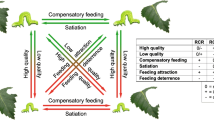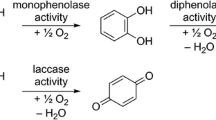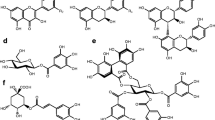Abstract
High foliar phenolics are generally assumed to increase resistance to insect herbivores, but recent studies show that tobacco lines modified to over– and underexpress phenolics do not exhibit higher constitutive resistance to caterpillars. This is contrary to the expectation that ingestion of tobacco phenolics, particularly chlorogenic acid, should cause oxidative stress in herbivores. We investigated free radical production and antioxidant capacity of fresh crushed leaves of tobacco lines exhibiting over a sixfold difference in chlorogenic acid content to test whether high phenolic concentrations are associated with increased production of reactive oxygen species (ROS). The effects of in planta phenolic levels on feeding behavior, growth, biochemical markers of oxidative stress, and the antioxidant capacity of midgut fluid and hemolymph were assessed in tobacco budworm, Heliothis virescens. The experiments showed that high phenolic foliage was more prooxidant than low phenolic foliage, but the net balance in crushed tissue was antioxidant in comparison to buffer and the commercial antioxidant standard, Trolox. In H. virescens, the antioxidant capacity of midgut fluid was also powerful, and caterpillars fed high phenolic foliage did not exhibit the expected markers of oxidative stress in midgut tissues (altered ascorbate ratios, disulfides, or total hydroperoxides). Instead, hemolymph of larvae fed high phenolic foliage exhibited improved total Trolox equivalent antioxidant capacity (TEAC). These results suggest that the elevated foliar phenolics in some plants may have beneficial antioxidant properties for herbivorous insects, much as dietary phenolics do in mammals.
Similar content being viewed by others
REFERENCES
AFANSAS'E, I. B., DOROZHKO, A. I., BRODSKII, V., KOSTYIK, A., and POTAPOVITCH, A. I. 1989. Chelating and free radical scavenging mechanisms of inhibitory action of rutin and quercetin in lipid peroxidation. Biochem. Pharmacol. 38:1763–1769.
AHMAD, S. 1992. Biochemical defense of pro-oxidant plant allelochemicals by herbivorous insects. Biochem. Syst. Ecol. 20:269–296.
AHMAD, S. and PARDINI, R. S. 1990. Antioxidant defense of the cabbage looper, Trichoplusia ni: Enzymatic responses to the superoxide-generating flavonoid, quercetin, and photodynamic furanocoumarin, xanthotoxin. Photochem. Photobiol. 51:305–311.
ALI, M. I., BI, J. L., YOUNG, S. Y., and FELTON, G. W. 1999. Do foliar phenolics provide protection to Heliothis virescens from a baculovirus? J. Chem. Ecol. 25:2193–2204.
ANDERSON, W. L. and WETLAUFER, D. B. 1975. A new method for disulfide analysis of peptides. Anal. Biochem. 67:493–502.
APPEL, H. 1993. Phenolics in ecological interactions: The importance of oxidation. J. Chem. Ecol. 19:1521–1552.
APPEL, H. M. 1994. The chewing herbivore gut lumen: Physicochemical conditions and their impact on plant nutrients, allelochemicals, and insect pathogens, pp. 210–223, in E. A. Bernays (ed.). Insect-Plant Interactions, Vol V. CRC Press, Ann Arbor, Michigan.
APPEL, H. M. and MARTIN, M. M. 1990. Gut redox conditions in herbivorous lepidopteran larvae. J. Chem. Ecol. 16:3277–3290.
APPEL, H. M. and SCHULTZ, J. C. 1992. Activity of phenolics in insects: The role of oxidation, pp. 609–620, in R. W. Hemingway and P. E. Laks (eds.). Plant Polyphenols, Plenum Press, New York.
BARBEHENN, R. V. and MARTIN, M. M. 1994. Tannin sensitivity in larvae of Malacosoma disstria (Lepidoptera): Roles of the peritrophic envelope and midgut oxidation. J. Chem. Ecol. 20:1985–2001.
BARBEHENN, R. V., BUMGARNER, S. L., ROOSEN, E. F., and MARTIN, M. M. 2001. Antioxidant defenses in caterpillars: Role of the ascorbate-recycling system in the midgut lumen. J. Insect Physiol. 47:349–357.
BATE, N. J., ORR, J., NI, W., MEROMI, A., NADLER-HASSAR, T., DOERNER, P. W., DIXON, R. A., LAMB, C. J., and ELKIND, Y. 1994. Quantitative relationship between phenylalanine ammonia-lyase levels and phenylpropanoid accumulation in transgenic tobacco identifies a rate-determining step in natural product synthesis. Proc. Natl. Acad. Sci. USA 91:7608–7612.
BERNAYS, E. A. 1981. Plant tannins and insect herbivores: An appraisal. Ecol. Entomol. 6:353–361.
BERNAYS, E. A., COOPER-DRIVER, G., and BILGENER, M. 1989. Herbivores and plant tannins. Adva. Ecol. Res. 19:263–275.
BI, J. L., FELTON, G. W., and MUELLER, A. J. 1994. Induced resistance in soybean to Helicoverpa zea: Role of plant protein quality. J. Chem. Ecol. 20:183–198.
BI, J. L., FELTON, G. W., MURPHY, J. B, HOWLES, P. A., DIXON, R. A., and LAMB, C. J. 1997a. Do plant phenolics confer resistance to specialist and generalist insect herbivores? J. Agric. Food Chem. 45:4500–4504.
BI, J. L., MURPHY, J. B., and FELTON, G. W. 1997b. Antinutritive and oxidative components as mechanisms of induced resistance in cotton to Helicoverpa zea. J. Chem. Ecol. 23:95–115.
BOER, G. DE and HANSON, F. E. 1987. Feeding responses to solanaceous allelochemicals by larvae of the tobacco hornworm, Manduca sexta. Entomol. Exp. Appl. 35:177–193.
DELANEY, T. P., UKNES, S., VERNOOIJ, B. FRIEDRICH, L., WEYMANN, K., NEGROTTO, D., GAFFNEY, T., GUT-RELLA, M., KESSMAN, H., WARD, and E., RYALS. 1994. A central role for salicylic acid in disease resistance. Science 266:1247–1250.
DUFFEY, S. S. and FELTON, G. W. 1991. Enzymatic antinutritive defenses of tomato plants against insects, pp. 167–197, in P. A. Hedin (ed.). Naturally Occurring Pest Bioregulators. American Chemical Society Symp. Ser. 449. Washington, D.C.
EICHENSEER, H., BI, J. L., and FELTON, G. W. 1998. Indiscrimination of Manduca sexta larvae to overexpressed and underexpressed levels of phenylalanine ammonia-lyase in tobacco leaves. Entomol. Exp. Appl. 87:73–78.
EICHENSEER, H., MATHEWS, M. C., BI, J. L., MURPHY, J. B., and FELTON, G. W. 1999. Salivary glucose oxidase: Multifunctional roles for Helicoverpa zea? Arch. Insect Biochem. Physiol. 42:99–109.
ELKIND, Y., EDWARDS, R., MAVANDAD, M., HEDRICK, S. A., RIBAK, O., DIXON, R. A., and LAMB, C. J. 1990. Abnormal plant development and down-regulation of phenylpropanoid biosynthesis in transgenic tobacco containing a heterologous phenylalanine ammonia-lyase gene. Proc. Natl. Acad. Sci. USA 87:9057–9061.
ELLIGER, C. A., WONG, Y., CHAN, B. G., and WAISS, A. C., JR. 1981. Growth inhibitor in tomato (Lycopersicon) to tomato fruitworm (Heliothis zea). J. Chem. Ecol. 5:753–758.
FEENY, P. P. 1976. Plant apparency and chemical defense, pp. 1–40, in J. Wallace and R. L. Mansell (eds.). Biochemical Interactions Between Plants and Insects. Recent Advances in Phytochemistry, Vol. 10, Plenum Press, New York.
FELTON, G. W. and DUFFEY, S. S. 1991. Protective action of midgut catalase in lepidopteran larvae against oxidative plant defenses. J. Chem. Ecol. 17:1715–1732.
FELTON, G. W., DONATO, K. K., DEL VECCHIO, R. J., and DUFFEY, S. S. 1989. Activation of plant foliar oxidases by insect feeding reduces nutritive quality of foliage for noctuid herbivores. J. Insect Physiol. 38:277–285.
FELTON, G. W., DONATO, K. K., DEL VECCHIO, R. J., BROADWAY, R. M., and DUFFEY, S. S. 1992. Impact of oxidized plant phenolics on the nutritional quality of dietary protein to a noctuid herbivore. J. Insect Physiol. 38:277–285.
FELTON, G. W., KORTH, K. L., BI, J. L., WESLEY, S. V., HUHMAN, D. V., MATHEWS, M. C., MURPHY, J. B., LAMB, C., and DIXON, R. A. 1999. Inverse relationship between systemic resistance of plants to microorganisms and to insect herbivory. Curr. Biol. 9:317–320.
FREI, B. 1994. Natural Antioxidants in Human health and Disease. Academic Press, New York.
GAFFNEY, T., FRIEDRICH, L., VERNOOIJ, B., NEGROTTO, D., NYE, G., UKNES, S., WARD, E., KESSMAN, H., and RYALS, J. 1993. Requirement of salicylic acid for the induction of systemic acquired resistance. Science 261:754–756.
GRYGLEWSKI, R. J., KORBUT, R., ROBAK, J., and SWIES, J. 1987. On the mechanism of antithrombic action of flavonoids. Biochem. Pharmacol. 36:317–322.
HARBORNE, J. B. 1991. Flavonoid Pigments, pp 389–429, in G. A. Rosenthal and M. B. Berenbaum (eds.). Herbiveres: Their Interactions with Secondary Plant Metabolites, Vol I. Academic Press, New York.
HERTZOG, M. G. L., SWEETNAM, P. M., FEHILY, A. M., ELMWOOD, P. C., and KROMHOUT, D. 1997. Antioxidant flavonols and ischemic heart disease in a Welsh population of men: The Caerphilly study. Am. J. Clin. Nutr. 65:1489–1494.
HODNICK, W. F., KALYANARAMAN, B., PRITSOS, C. A., and PARDINI, R. S. 1989. The production of hydroxyl and semiquinone free radicals during the autooxidation of redox active flavonoids, pp. 149–152, in M. G. Simic, K. A. Taylor, J. F. Ward, and C. von Sonntag (eds.). Oxygen Radicals in Biology and Medicine. Plenum Press, New York.
HOOVER, K., KISHIDA, K. T., DIGIORGIO, L. A., WORKMAN, J., ALANIZ, S. A., HAMMOCK, B. D., and DUFFEY, S. S. 1998a. Inhibition of baculoviral disease by plant-mediated peroxidase activity and free radical generation. J. Chem. Ecol. 24:1949–2000.
HOOVER, K., STOUT, M., ALANIZ, S. A., HAMMOCK, B. D., and DUFFEY, S. S. 1998b. Influence of induced plant defenses in cotton and tomato on the efficacy of baculoviruses on noctuid larvae. J. Chem. Ecol. 24:253–271.
HOOVER, K., YEE, J. L., SCHULTZ, C. M., ROCKE, D. M., HAMMOCK, B. D., and DUFFEY, S. S. 1998c. Effects of plant identity and chemical constituents on the efficacy of a baculovirus against Heliothis virescens. J. Chem. Ecol. 24:221–252.
HOWLES, P. A., SEWALT, V. J. H., PAVIA, N. J., ELKIND, Y., BATE, N. J., LAMB, C., and DIXON, R. A. 1996. Overexpression of L-phenylalanine ammonia-lyase in transgenic tobacco plants reveals control points for flux into phenylpropanoid biosynthesis. Plant Physiol. 112:1617–1624.
ISMAN, M. B. and DUFFEY, S. S. 1982a. Toxicity of tomato phenolic compounds to the fruitworm, Heliothis zea. Entomol. Exp. Appl. 31:370–376.
ISMAN, M. B. and DUFFEY, S. S. 1982b. Phenolic compounds in the foliage of commercial tomato cultivars as growth inhibitors to the fruitworm, Heliothis zea. J. Am. Hortic. Sci. 107:167–170.
ISMAN, M. B. and DUFFEY, S. S. 1983. Pharmacokinetics of chlorogenic acid and rutin in larvae of Heliothis zea. J. Insect Physiol. 29:295–300.
JIANG, Z., HUNT, J. V., and WOLFF, S. P. 1992. Ferrous iron oxidation in the presence of xylenol orange for detection of lipid hydroperoxides in low density lipoprotein. Anal. Biochem. 202:384–389.
JOHNSON, K. S. and BARBEHENN, R. V. 2000. Oxygen levels in the gut lumens of herbivorous insects. J. Insect Physiol. 46:897–903.
KAHL, R. 1991. Protective and adverse biological actions of phenolic antioxidants, pp. 245–273, in H. Seis (ed.). Oxidative Stress: Oxidants and Antioxidants. Academic Press, New York.
LEE, K. and BERENBAUM, M. R. 1989. Action of antioxidant enzymes and cytochrome P-450 monooxygenases in the cabbage looper in response to plant phototoxins. Arch. Insect Biochem. Physiol. 10:151–162.
LINDROTH, R. L. and PETERSON, S. S. 1988. Effects of plant phenols on performance of southern armyworm larvae. Oecologia 75:185–189.
MAHER, E. A., BATE, N. J., NI, W., ELKIND, Y., DIXON, R. A., and LAMB, C. J. 1994. Increased disease susceptibility of transgenic tobacco plants with suppressed levels of preformed phenylpropanoid products. Proc. Natl. Acad. Sci. USA 91:7802–7806.
MARTIN, J. S., MARTIN, M. M., and BERNAYS, E. A. 1987. Failure of tannic acid to inhibit digestion or reduce digestibility of plant protein in gut fluids of insect herbivores: Implications for theories of plant defense. J. Chem. Ecol. 13:605–621.
MATHEWS, M. C., SUMMERS, C. B., and Felton, G. W. 1997. Ascorbate peroxidase: A novel antioxidant enzyme in insects. Arch. Insect Biochem. Physiol. 34:57–68.
MAXWELL, S. R. J. 1997. Wine antioxidants and their impact on antioxidant activity in vivo, pp 150–165, in T. R. Watkins (ed.). Wine: Nutritional and Therapeutic Benefits. American Chemical Society, Washington, D.C.
MILLER, N. J. and RICE-EVANS, C. A. 1994. Total antioxidative status in plasma and body fluids. Methods Enzymol. 234:279–293.
MORONEY, M. A., ALCARAC, M. J., FORDER, R. A., CAREY, F., and HOULT, J. R. S. 1988. Selectivity of neutrophil 5-lipoxygenase and cyclo-oxygenase inhibition by an anti-inflammatory flavonoid glycoside and related aglycone flavonoids. J. Pharm. Pharmacol. 40:787–792.
PALLAS, J. A., PAIVA, N. L., LAMB, C., and DIXON, R. A. 1996. Tobacco plants epigenetically suppressed in phenylalanine ammonia-lyase expression do not develop systemic acquired resistance in response to infection by tobacco mosaic virus. Plant J. 10:281–293.
PINCEMAIL, J., DEBY, C., LION, Y., BRAQUET, P., HANS, P., DRIEU, K., and GOUTIER, R. 1986. Role of flavonoids in lipoperoxidation and radicalar reactions, pp 423–436, in L. Parkas, M. Gabor, and F. Kallay (eds.). Flavonoids and Bioflavonoids. Elsevier, Amsterdam, The Netherlands.
PRITSOS, C. A., AHMAD, S., BOWEN, S. M., ELLIOTT, A. J., BLOMQUIST, G. J., and PARDINI, R. S. 1988. Antioxidant enzymes of the black swallowtail butterfly, Papilio polyxenes, and their response to the prooxidant allelochemical, quercetin. Arch. Insect Biochem. Physiol. 8:101–112.
REESE, J. C., and BECK, S. D. 1976. Effects of allelochemicals on the black cutworm, Agrotis ipsilon; effects of catechol, L-DOPA, dopamine and chlorogenic acid on larval growth, development and utilization of food. Ann. Entomol. Soc. Am. 69:68–72.
RICE-EVANS, C. A., MILLER, N. J., BOLWELL, P. G., BRAMLEY, P. M., and PRIDHAM, J. B. 1995. The relative antioxidant activities of plant-derived polyphenolic flavonoids. Free Radic. Res. 22:375–383.
RICE-EVANS, C. A., MILLER, N. J., and PAGANGA, G. 1996. Structure-antioxidant activity relationships of flavonoids and phenolic acids. Free Radic. Biol. Med. 20:933–956.
SEWALT, V. J. H., NI, W., JUNG, H. G., and DIXON, R. A. 1997. Lignin impact on fiber degradation: Increased enzymatic digestibility of genetically engineered tobacco (Nicotiana tabacum) stems reduced in lignin content. J. Agric. Food Chem. 45:1977–1983.
STAMP, N. E. and YANG, Y. 1996. Response of insect herbivores to multiple allelochemicals under different thermal regimes. Ecology 77:1088–1102.
STAMP, N. E., TEMPLE, M., TRAUGOTT, M. S., and WILKENS, R. T. 1994. Temperature-allelochemical interactive effects on performance of Manduca sexta caterpillars. Entomol. Exp. Appl. 73:199–210.
STEINLY, B. A. and BERENBAUM, M. 1985. Histopathological effects of tannins on the midgut epithelium of Papilio polyxenes and Papilio glaucus. Entomol. Exp. Appl. 39:3–9.
SUMMERS, C. B. and FELTON, G. W. 1994. Prooxidant effects of phenolic acids on the generalist herbivore Helicoverpa zea (Lepidoptera: Noctuidae): potential mode of action for phenolic compounds in plant anti-herbivore chemistry. Insect Biochem. Mol. Biol. 24:943–953.
TAKAHAMA, U. 1985. O2 - dependent and independent photooxidation of quercetin in the presence and absence of riboflavin and effect of ascorbate on the photooxidation. Photochem. Photobiol. 42:89–91.
WAISS, A. C., CHAN, B. G., ELLIGER, C. A., DRYER, D. L., BINDER, R. G., and GULEDNER, R. C. 1981. Insect growth inhibitors in crop plants. Entomol. Soc. Am. Bull. 27:217–221.
WRUBEL, R. P. and BERNAYS, E. A. 1990. The relative insensitivity of Manduca sexta to non-host plant secondary compounds. Entomol. Exp. Appl. 54:117–124.
YANG, Y., STAMP, N. E., and OSIER, T. L. 1996. Effects of temperature, multiple allelochemicals and larval age on the performance of a specialist caterpillar. Entomol. Exp. Appl. 79:335–344.
Author information
Authors and Affiliations
Rights and permissions
About this article
Cite this article
Johnson, K.S., Felton, G.W. Plant Phenolics as Dietary Antioxidants for Herbivorous Insects: A Test with Genetically Modified Tobacco. J Chem Ecol 27, 2579–2597 (2001). https://doi.org/10.1023/A:1013691802028
Issue Date:
DOI: https://doi.org/10.1023/A:1013691802028




